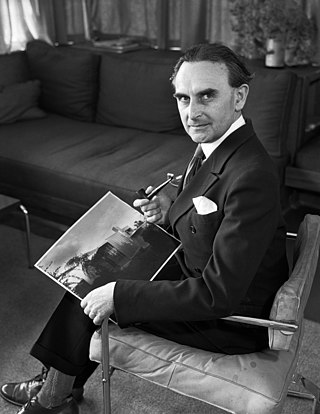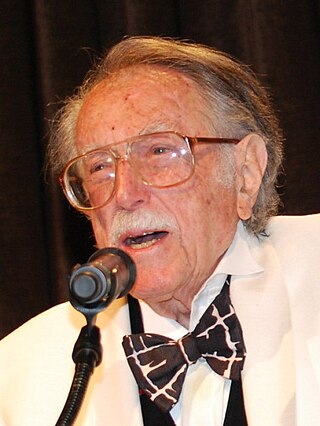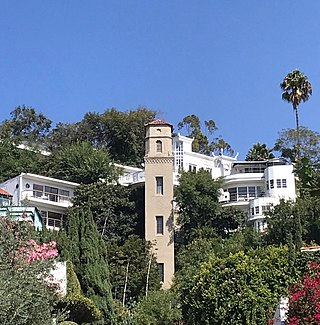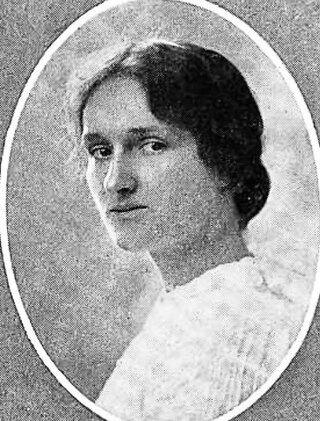
Richard Joseph Neutra was an Austrian-American architect. Living and building for most of his career in Southern California, he came to be considered a prominent and important modernist architect. His most notable works include the Kaufmann Desert House, in Palm Springs, California.

The International Style or internationalism is a major architectural style that developed in the 1920s and 1930s and was closely related to modernism and modernist architecture. It was first defined by Museum of Modern Art (MoMA) curators Henry-Russell Hitchcock and Philip Johnson in 1932, based on works of architecture from the 1920s. The terms rationalist architecture and modern movement are often used interchangeably with International Style, although the former is mostly used in the English-speaking world to specifically refer to the Italian rationalism, or even the International Style that developed in Europe as a whole.

Frank Lloyd Wright Jr., commonly known as Lloyd Wright, was an American architect, active primarily in Los Angeles and Southern California. He was a landscape architect for various Los Angeles projects (1922–1924), provided the shells for the Hollywood Bowl (1926–1928), and produced the Swedenborg Memorial Chapel at Rancho Palos Verdes, California (1946–1971). His name is frequently confused with that of his more famous father, Frank Lloyd Wright.

The Lovell House or Lovell Health House is an International style modernist residence designed and built by Richard Neutra between 1927 and 1929. The home, located at 4616 Dundee Drive in the Los Feliz neighborhood of Los Angeles, California, was built for the physician and naturopath Philip Lovell. It is considered a major monument in architectural history, and was a turning point in Neutra's career.

The Schindler House, also known as the Schindler Chace House or Kings Road House, is a house in West Hollywood, California, designed by architect Rudolph M. Schindler. The house serves as headquarters to the MAK Center for Art and Architecture, which operate and program three Schindler sites, and is owned and conserved by the Friends of Schindler House.

The Aline Barnsdall Hollyhock House in the East Hollywood neighborhood of Los Angeles, California, was designed by Frank Lloyd Wright originally as a residence for oil heiress Aline Barnsdall. The building is now the centerpiece of the city's Barnsdall Art Park. In July 2019, along with seven other buildings designed by Wright in the 20th century, it was added to the UNESCO World Heritage List. It is the first time modern American architecture has been recognized on the World Heritage List. The Hollyhock House is noted for developing an influential architectural aesthetic, which combined indoor and outdoor living spaces.
Gregory Samuel Ain was an American architect active in the mid-20th century. Working primarily in the Los Angeles area, Ain is best known for bringing elements of modern architecture to lower- and medium-cost housing. He addressed "the common architectural problems of common people".

Barnsdall Art Park is a city park located in the East Hollywood district of Los Angeles, California. Parking and arts buildings access is from Hollywood Boulevard on the north side of the park. The park is a Los Angeles Historic-Cultural Monument, and a facility of the City of Los Angeles Department of Cultural Affairs.

Julius Shulman was an American architectural photographer best known for his photograph "Case Study House #22, Los Angeles, 1960. Pierre Koenig, Architect." The house is also known as the Stahl House. Shulman's photography spread the aesthetic of California's Mid-century modern architecture around the world. Through his many books, exhibits and personal appearances his work ushered in a new appreciation for the movement beginning in the 1990s.

The Lovell Beach House is located on the Balboa Peninsula in Newport Beach, California. The building was completed in 1926 and is now recognized as one of the most important works by architect Rudolf Schindler, second only to the Schindler House, built four years earlier for his family as a show house and studio. Both of these early houses by Schindler are considered landmarks of early modern architecture in America.
Edward Hale Fickett, FAIA, was an American architect who was a consultant to federal and local governments in the United States and to President Dwight D. Eisenhower.

Jardinette Apartments, now known as Marathon Apartments, is a four-story apartment building in Hollywood, Los Angeles, California, designed by modernist Richard Neutra. It was Neutra's first commission in the United States. In his book Key Buildings of the Twentieth Century, Richard Weston called the Jardinette Apartments "one of the first Modernist buildings in America." It has also been called "America's first multi-family, International-style building."

The Samuel Freeman House is a Frank Lloyd Wright house in the Hollywood Hills of Los Angeles, California built in 1923. The house was listed on the National Register of Historic Places in 1971. The house is also listed as California Historical Landmark #1011 and as Los Angeles Historic-Cultural Monument #247.

The Neutra Office Building is a 4,800-square-foot (450 m2) office building in the Silver Lake section of Los Angeles, California. The building was owned and designed by Modernist architect Richard Neutra in 1950. It served as the studio and office for Neutra's architecture practice from 1950 until Neutra's death in 1970. The building has been declared a Historic Cultural Monument and listed on the National Register of Historic Places. It was listed for sale in 2007 at an asking price of $3,500,000.

Galka Scheyer was a German-American painter, art dealer, art collector, and teacher. She was the founder of the "Blue Four," an artists' group that consisted of Lyonel Feininger, Wassily Kandinsky, Paul Klee and Alexej von Jawlensky.

Hollywood Heights is a neighborhood in the Hollywood Hills of Los Angeles, bounded by the Hollywood Bowl on the north, Highland Avenue on the east, Outpost Estates on the west, and Franklin Avenue on the south. It includes a number of notable historic homes and buildings and has been home to numerous people in the film and music industries, dating back to the silent film era.

Pauline Gibling Schindler was an American composer, educator, editor, and arts promoter, especially influential in supporting modern art in Southern California. Her husband was architect Rudolph Schindler.
Jack Allen Charney was an American mid-century architect who designed a number of significant buildings in various cities across California, including Los Angeles, Beverly Hills, San Francisco and Long Beach. His designs include the 32-story Sierra Towers in West Hollywood, from 1965.
Michael Rotondi is an American architect and educator. He has been a member of two international practices. He attended the Southern California Institute of Architecture when it began (SCI-Arc) in 1972 and, later, was director of the graduate program there.

The MAK Center for Art and Architecture is an art museum and cultural center headquartered in the Schindler House in West Hollywood, California, United States. It is affiliated with the Museum of Applied Arts, Vienna (MAK). The Center is situated in three architectural landmarks, designed by Austrian-American architect R.M. Schindler. The center operates a residency program, an exhibition space at the Mackey Apartments and a study center at the Fitzpatrick-Leland House.
















